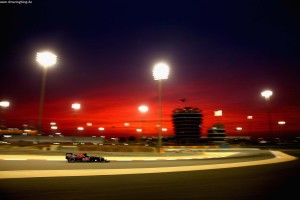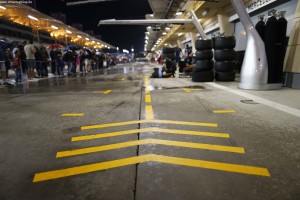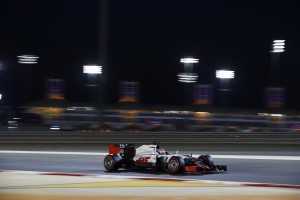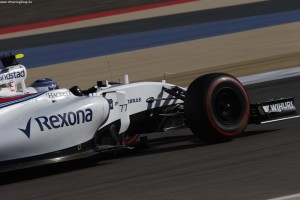The Bahrain Grand Prix has provided a good combination of overtaking and fast-reaction race strategy for the past two seasons and this year’s race was another excellent example.
Although we lost one of the main protagonists Sebastian Vettel before the start, the remaining Ferrari of Kimi Raikkonen had the pace to finish second, while Lewis Hamilton’s challenge again stumbled with a poor start. Behind those three podium finishers, there was a very tight and tense battle for positions and race strategy played a fundamental part in the finishing order of those cars. Here we will explore why it went very well for some teams and badly for others and how the Haas team again rode their luck.
Pre-race considerations
 This year’s race took place two weeks earlier that last season’s and the temperatures were lower as a result. In fact all weekend the weather was unusually cool. This played a significant factor in the strategy and was one of the things that promoted the use of the supersoft tyre in the race. The medium compound is another that operates in a lower working range normally, but it proved not to be competitive in the race.
This year’s race took place two weeks earlier that last season’s and the temperatures were lower as a result. In fact all weekend the weather was unusually cool. This played a significant factor in the strategy and was one of the things that promoted the use of the supersoft tyre in the race. The medium compound is another that operates in a lower working range normally, but it proved not to be competitive in the race.
None of the three tyre compounds looked very good in Friday practice and some teams were tricked into thinking that the medium could be a good flexible option offering better durability and reasonable pace. In fact the pace was much slower in the race. Bahrain is a track that always rubbers in over the weekend and that tends to favour the softer tyres as the race goes on. The medium turned out to be 1.5secs a lap slower than the soft. Some teams paid heavily for that, including Williams.
In 2015 with only two tyre choices, the default race strategy was two stops for most cars, but this year the simulations showed that three stops was faster. However it carries risks; coming out into traffic in particular. This was an unusual race where many cars, including the podium finishers, all changed their strategy during the race. We may see quite a bit of this during the season, now that we have the three tyre compound rules, which have energised the sport positively.
All the front-runners change strategy mid race
 Nico Rosberg won the race, ahead of Kimi Raikkonen and Lewis Hamilton. The race was effectively handed to Rosberg at the start when pole sitter Hamilton again got a poor getaway and after tangling with Valtteri Bottas, he fell to seventh. Raikkonen also had a poor start and dropped to fifth behind Daniel Ricciardo. However by the second stint, both men had worked their way up to their eventual finishing positions.
Nico Rosberg won the race, ahead of Kimi Raikkonen and Lewis Hamilton. The race was effectively handed to Rosberg at the start when pole sitter Hamilton again got a poor getaway and after tangling with Valtteri Bottas, he fell to seventh. Raikkonen also had a poor start and dropped to fifth behind Daniel Ricciardo. However by the second stint, both men had worked their way up to their eventual finishing positions.
Rosberg had planned a two-stop race, with a second stint on softs and a final stint on mediums. But Mercedes moved away from that as the race unfolded, due to a change that the team triggered itself by trying to get Hamilton ahead of Raikkonen. On a recovery strategy, Hamilton had taken the medium tyre at the first stop, the idea being to wait for the opportunity to undercut Raikkonen at the second stops. It didn’t happen because the bodywork on Hamilton’s car had been damaged in the first lap collision and so was around a second slower than anticipated. So Mercedes tried a different tactic; switch Hamilton onto the supersoft tyres and try to close up the gap for an attack at the third stop.
The intention was to get Ferrari to cover Hamilton by doing the same move, which they did. This also meant that Rosberg had to be moved to the same plan, to cover Raikkonen. As the car that pitted last, Rosberg always had the fresher tyre advantage, so there was no threat to his lead.
Although Hamilton did close the gap, the Ferrari had the pace to ease away from him in that third stint and it was clear then that the race would finish as it was. It showed that, despite Vettel’s problem, the Ferrari has closed up on Mercedes and when it gets a new turbo solution at the Spanish Grand Prix, the Ferrari should be right with Mercedes on race pace.
Grosjean and Haas ride their luck again as dream start continues
 The Haas team was lucky in Australia that a red flag came out before Romain Grosjean had pitted and so he got a free pit stop and finished sixth. In Bahrain, they played a canny game and got an outstanding fifth place result, but again luck played a part, as they had taken a big risk in their strategy planning.
The Haas team was lucky in Australia that a red flag came out before Romain Grosjean had pitted and so he got a free pit stop and finished sixth. In Bahrain, they played a canny game and got an outstanding fifth place result, but again luck played a part, as they had taken a big risk in their strategy planning.
The Haas team has said that it always intended to run an aggressive three-stop strategy, based on supersoft tyres. They planned it on Saturday, by saving two sets of new supersoft tyres, deliberately sacrificing eighth place on the grid to Hulkenberg and a slot in Q3. This gave Grosjean the right to start the race on new supersoft tyres and thus to gain a few extra laps on the cars in front of him. They got lucky because Hulkenberg was involved in contact on the opening lap and had to pit. From then on Grosjean was able to run at his desired pace. If that had not happened, it might not have been so smart to have sacrificed a grid position.
Here’s how that calculation works: You are trading off the benefit of a new set of tyres against a grid slot and in general a new set of tyres is worth around 2 seconds over a stint compared to a used set. But a grid slot is precious, especially if sacrificing it means that you are held up. The Force India was slower than the Haas in Bahrain and Grosjean’s race would have been compromised by following Hulkenberg for that opening stint. He’d have had to undercut him at the first stop, would have dropped out into traffic, made his strategy suboptimal and he would have had a less smooth ride generally.
It’s unusual to sacrifice a grid slot for a new set of tyres, especially for a car as fast as the Haas. It is faster than the Williams and the Toro Rosso, so it was a huge gamble. It’s possible that Haas didn’t realise going into the weekend just how fast that car is. They certainly do after this race. But it worked in this case and once again it’s an example of some bold thinking from F1’s newest team, that has really started its F1 career brightly If you consider that many established teams did not have such a strong performance operationally, its even more remarkable that Haas has had two races like these. It shows that there’s more to this team than just a fast car, developed with Ferrari.
Williams make some confusing moves and lose a strong result
 Williams confused their peers in Bahrain with their strategy operations. Looking at the list of tyres each team had available for the race, Williams were the outliers, with no new soft tyres. They had tyres that had done an installation lap only, but it was clear that they felt the medium tyre was the one to go with. It was the wrong bet; the medium was 1.5s slower than the soft in the race. Felipe Massa was in a superb second position after the start, but the team failed to capitalise on it, by making him run most of the race – 50 laps – on the medium. He finished eighth.
Williams confused their peers in Bahrain with their strategy operations. Looking at the list of tyres each team had available for the race, Williams were the outliers, with no new soft tyres. They had tyres that had done an installation lap only, but it was clear that they felt the medium tyre was the one to go with. It was the wrong bet; the medium was 1.5s slower than the soft in the race. Felipe Massa was in a superb second position after the start, but the team failed to capitalise on it, by making him run most of the race – 50 laps – on the medium. He finished eighth.
So what happened?
Massa and Williams fell victim to something we have seen before, whereby Red Bull and Daniel Ricciardo made an aggressive early stop to trigger reaction from the cars ahead. This pushes them into doing longer stints than they want to. Ricciardo can make the tyres last, many rivals cannot.
Ricciardo pitted for soft tyres at the end of Lap 6 and Massa covered him a lap later, moving onto the mediums. This brought him out into traffic behind Wehrlein, Nasr and Ericsson. The pace was not there on the medium and Ricciardo, Kvyat, Grosjean and Verstappen all passed him. Playing the long game on two stops, he had track position advantage over Kvyat and Verstappen after their third stops, but they used the superior pace of the supersofts in the final stint to overpower him and push him down to eighth on a tough day for Williams, where Bottas’ race was ruined by the collision with Hamilton and the penalty he received for it.


